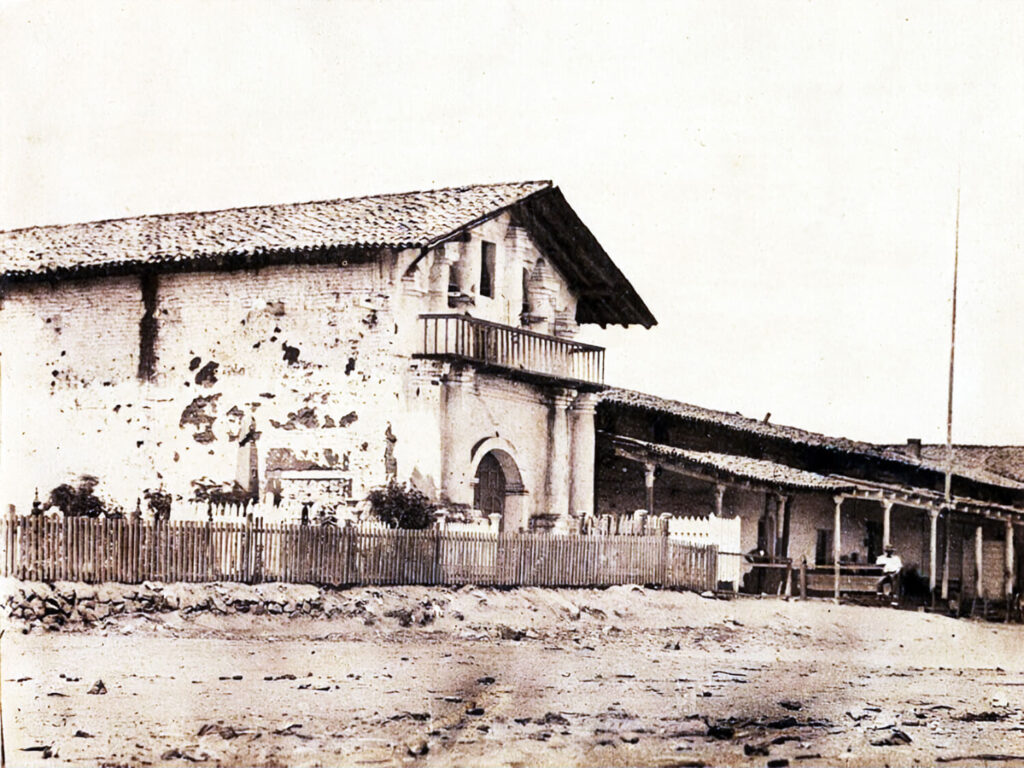California Mission
Dolores San Francisco de Asís
3321 16th Street, San Francisco, CA 94114
Native Life
Mission Dolores was established in the ancestral territory of Ohlone and Miwok peoples, in the area known today as San Francisco. The Bay Area region was home to the largest native populations in what is now California. It is estimated that over forty different tribal groups with more than a dozen different native languages thrived in this area. The bay was abundant in nutritious resources. The native people living here harvested acorns and hunted deer, rabbits, fresh fish and shellfish. Some native people describe these traditional areas of hunting and harvesting, now referred to as estuaries, as “Indian Shopping Malls.” They were full of diverse resources that could be used shelter, food, clothing and everyday living.
Cultural Impacts

The Spanish attempted to force Indians to assimilate into Spanish culture and give up their traditional way of life. Indians were forced to change their religious beliefs, diet, and daily routines, though many Indians resisted. Missionaries required Indians to study Christianity, Spanish language, and Spanish customs in order to assimilate into Spanish life. California Indians were forbidden from speaking in their native languages, practicing traditional religious ceremonies, and eating traditional foods. Sugar and milk were introduced to the diet of Indians working the missions, leading to tooth decay, life threatening infections, diabetes and other health issues. Within two years of living in the missions, many Indians lost all of their teeth.
Indians also struggled with the livestock and diseases that the Spanish brought to California. Indians used various techniques, like burning small areas of the forest to restore nutrients to the soil, in order to work the land and harvest plants for food and medicine. Cows, goats, pigs, and chickens overgrazed the lands tended by Indians, turning Indian crops into trampled wilderness. Livestock forced native animals to compete for food, throwing the ecosystem out of balance. The Spanish also brought diseases like Measles, Influenza and Small Pox to California. Unlike the Spanish, the native peoples did not have the opportunity to build up natural immunities to these diseases. The introduction of European diseases devastated native populations, wiping out entire villages.
Colonization & Governance
The Spanish plan for governance and maintenance of the missions in California was supposed to be carried out over a ten year period. The plan called for the missionaries to “convert” the Indians to Christianity and “train” them to perform manual labor. After a period of ten years it was anticipated that the Franciscan missionaries would turn their missions over to parish priests and the Indians in the missions would live “assimilated” into Spanish culture in Indian “pueblos” or towns. This ten year plan was actually carried out over the course of fifty years. There were many factors that contributed to things not going as they had planned. There were large scale resistance efforts by California Indian tribes. The rate of disease and death was high among populations of Indians at the missions. Thus the military and church expended vast resources on continual expeditions to “capture” Indians in the regions of California that had thus far been untouched by disease. Additionally, California Indians did not adopt religious practices and Spanish culture in a way that was satisfactory to the church and government authorities. Thus, the Indian people would have to be forced to maintain the lifestyle the Spanish planned to assimilated them to under a colonial authority.
Resistance
California Indians engaged in widespread resistance to Spanish colonization. Resistance came in many forms. Large scale revolts were organized simultaneously among multiple Indians at several missions. Many individuals and groups attempted to escape. Stock raids were organized with other tribal groups. Others refused to work, attend church services, or bear children fathered by Spanish soldiers. Some groups continued to practice their traditions and ceremonies in secret. Indians were punished by the missionaries for exercising these forms of resistance. Native accounts of punishment describe executions, whippings, shackling, confinement, being made to wear wooden collars with metal hooks and many other forms of physical and psychological humiliation and cruelty.
Secularizations
Mexico won their independence from Spain in 1821 and took control of California. The Mexican government passed laws in 1834 to secularize the missions, meaning that the government took control over the missions away from the priests and gave it to the Indians. The initial plan was for the secularized missions to become Indians towns, or pueblos, and to divide half of the land for the Indians and the other half for the priests. The Indians were also instructed to tend the common area between the two pieces of land. A Mexican government administrator was assigned to each mission to inventory property, livestock and other items of value. Upon the completion of the inventory the official was in charge of distributing the land and valuables to the Indians. Five Indian pueblos were established in total: Flores, Pala, San Dieguito, San Juan Capistrano and San Pasqual.
General Information
Mission Dolores San Francisco De Asis
CA aboriginal people:
Ohlone, Bay Miwok, Coast Miwok and Patwin tribes.
Current CA Indian tribe(s) in area:
Lytton Rancheria (Federally Recognized)
1300 N. Dutton Avenue, Suite A
Santa Rosa, CA 95401
(707) 575-5917 Phone
(707) 575-6974 Fax
Muwekma Ohlone Tribe
2574 Seaboard Avenue
San Jose, CA 95131.
(408) 383-9318 Phone
muwekma@muwekma.org

